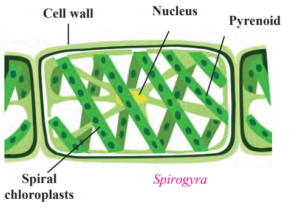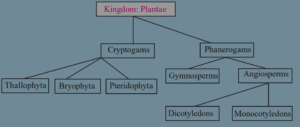MSBSHSE Class 9 Science Chapter 6 Solution – Classification of Plants
MSBSHSE Class 9 Science Chapter 6 Solution – Classification of Plants
https://biosimplified.com/maharashtra-state-board-science-solution-part-2-animal-classification/
MSBSHSE CLASS 9 SCIENCE CHAPTER 6 SOLUTION – CLASSIFICATION OF PLANTS
Q 1) Match the proper terms from columns A and C with the description in column B.
Solution –
| A | B | C |
| Thallophyta | These are mainly Grow in water | Algae |
| Bryophyta | These plants Needs water for Reproduction | Moss |
| Pteridophyta | Tissues are present for conduction of water and food | Fern |
| Gymnosperm | No Natural covering on seeds | Cycas |
| Angiosperm | Seeds are formed in Fruits | Tamarind |
Q2) Complete the sentences by filling in the blanks and explain those statements.
a) ……. plants have soft and fibre – like body
Solution – Thallophyta
b) ……………….. is called the‘ amphibian’ of the plant kingdom.
Solution – Bryophyta
c) In pteridophytes, asexual reproduction occurs by ……………….. formation and sexual reproduction
occurs by ………………..formation.
Solution – Spore , Zygote
d) Male and female flowers of………………..are borne on different sporophylls of the same plant.
Solution – Gymnosperms
Q 3) Answer the following question in your own words
a) Write the charateristics of subkingdom Phanerogams.
Solution –
Phanerogams are the plants that posses special structure for reproduction and produces Seeds are known as phanerogams
after the process of reproduction and the seed is formed and the contains the embryo and Stored food
at the time of germination the stored food is used for the growth initial growth of embryo
the Phanerogams are further classified as
1) Gymnosperms
2) Angiosperms
2) Distinguish between monocots and dicots.
Solution –
| Monocot | Dicot | |
| Seed | Contain 1 cotyledon | Contain 2 cotyledon |
| Root | Have fibrous root system | Have Tap root system |
| Stem | May have hollow ,disc, or false stem
Ex 1) Hollow – Bamboo 2) Disc like – Onion 3) False – Banana |
Have very Strong & Hard stem
Ex – Banyan tree |
| Leaf | They have Parallel leaf Venation | They posses Reticulate Venation |
| Flower | Flowers are Trimerous
Trimerous – flowers have 3 parts or are in their multiple |
Flowers are Tetramerous or Pentamerous
Tetramerous – flower have 4 parts or are in their multiple Pentamerous – flowers have 5 parts or are in their multiple |
| Example | Cereals | Pulses |
c) Write a paragraph in your own words about the ornamental plants called ferns.
Solution –
Ferns are mainly grown in the gardens because the ferns have beautiful leaves
the ferns posses leaves , stem , and roots but they do not produce flowers and seed
because of their attractive appearance they are use as Ornamental plants in the garden
d) Sketch, label and describe the Spirogyra.

Spirogyra –
these plants mainly grows in water
they don’t posses parts such as root, stem, flower
they are Autotrophic because they poses chlorophyl and due it they can perform Photosynthesis
they could be vary in size
e) Write the characteristics of the plants belonging to division Bryophyta
Solution –
The plants are thalloid, multicellular and are autotrophic
The Bryophyta are called as Amphibians of the kingdom plant because they grow in land but require water for the the reproduction
the plants are thalloid and multicellular and are Autotrophic
The Bryophyta reproduce by spore formation
Structure of Bryophytes –
it is flat & ribbon-like long,
These plants are without true roots, stem and leaves.
But Instead of that they posses stem-like or
leaf-like parts and root-like rhizoids.
These plants do not have specific tissues for conduction of food and Water
example – Riccia , Anthoceros , Marchantia , Moss
6 ) Which criteria are used for the classification of plants? Explain with reasons
The presence or absence of organs is the first criterion for classification of plants.
The presence or absence of separate conducting tissues for conduction of water and food
the very next consideration for classification is that Do the plants bear
seeds?
reason – If they have then they are called Flowering plants & if they dont have they are called as Non Flowering plants
The Next criteria for classification of plant is whether the seeds are enclosed in a
fruit or not
Reason is that if seeds are enclosed in fruit they are known as Angiosperm and if seeds are naked they are known as Gymnosperm
Plants are also classified on the basis of the number of
cotyledons present in the seed
Reason if the seed have 1 cotyledon it is known as monocot
if the seed have 2 cotyledons it known as dicot

